A beef curry typically takes 2-3 hours of cooking to achieve fork-tender beef, but when I worked in a Thai restaurant, I learned a trick to make it faster without compromising flavour even one bit. The whole thing comes together in under an hour, which means you can have an authentic Thai beef curry on any night of the week; no Instant Pot needed!
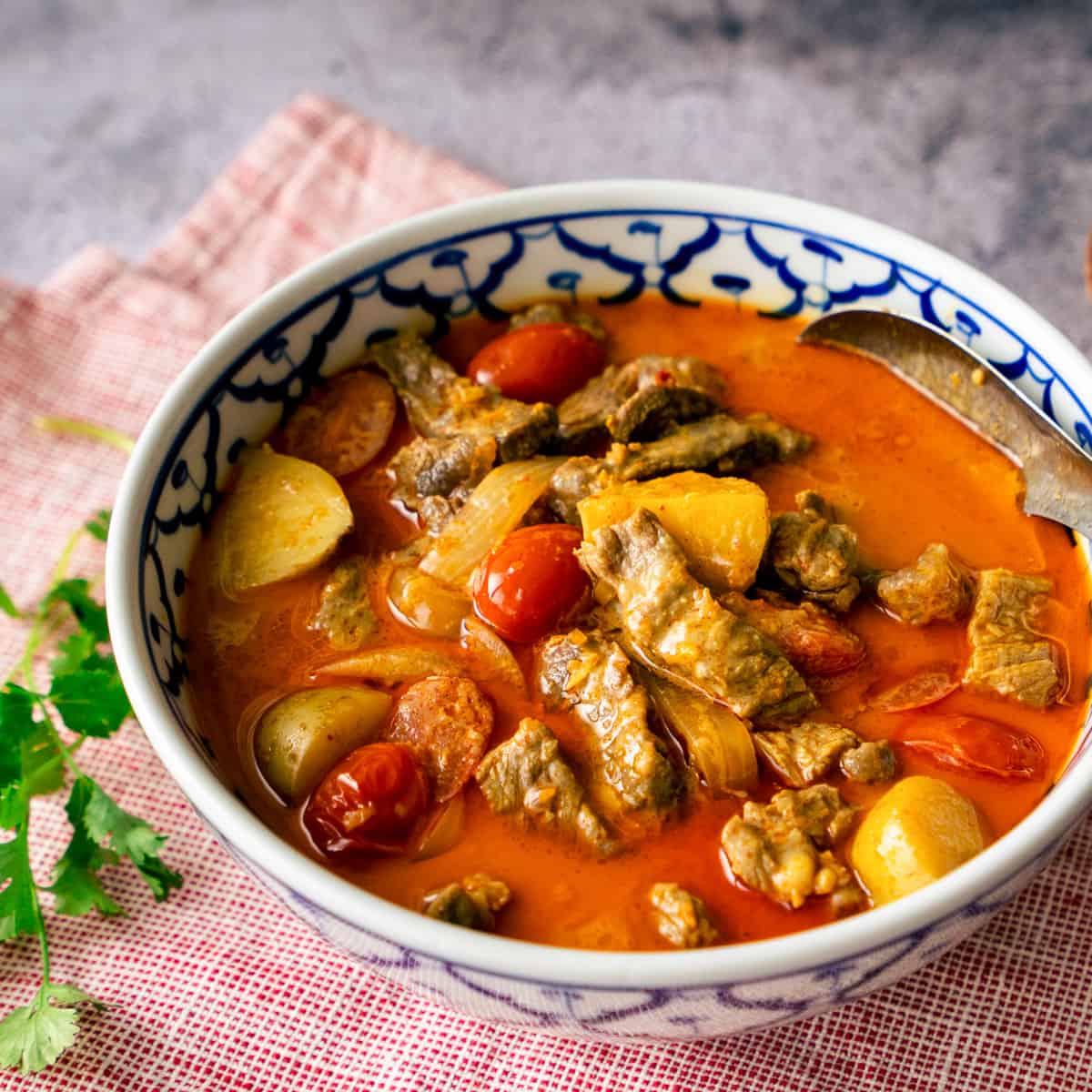
What is yellow curry?
Known in Thai as gaeng garee or keang kari, yellow curry is one of the most well-known curries in Thai cuisine. It is unique in a few ways:
- The spice level is typically the lowest of all curries, so it's a great for kids too.
- It's a specialty of Thai Muslims; so unlike other curries, in Thailand you will find yellow curry with chicken or beef, but never pork.
- It is always made with potatoes and onions, whereas with many other Thai curries, the vegetable options are more flexible.
- The yellow color comes from turmeric, which is not a spice that's super common in Thai curries, despite popular belief.
Also check out my Thai Yellow Chicken Curry Recipe!
Ingredients
Here are the ingredients you'll need for the curry. (Note that the picture below is missing the curry paste because I'm making mine from scratch 😄 ... but you don't have to.)
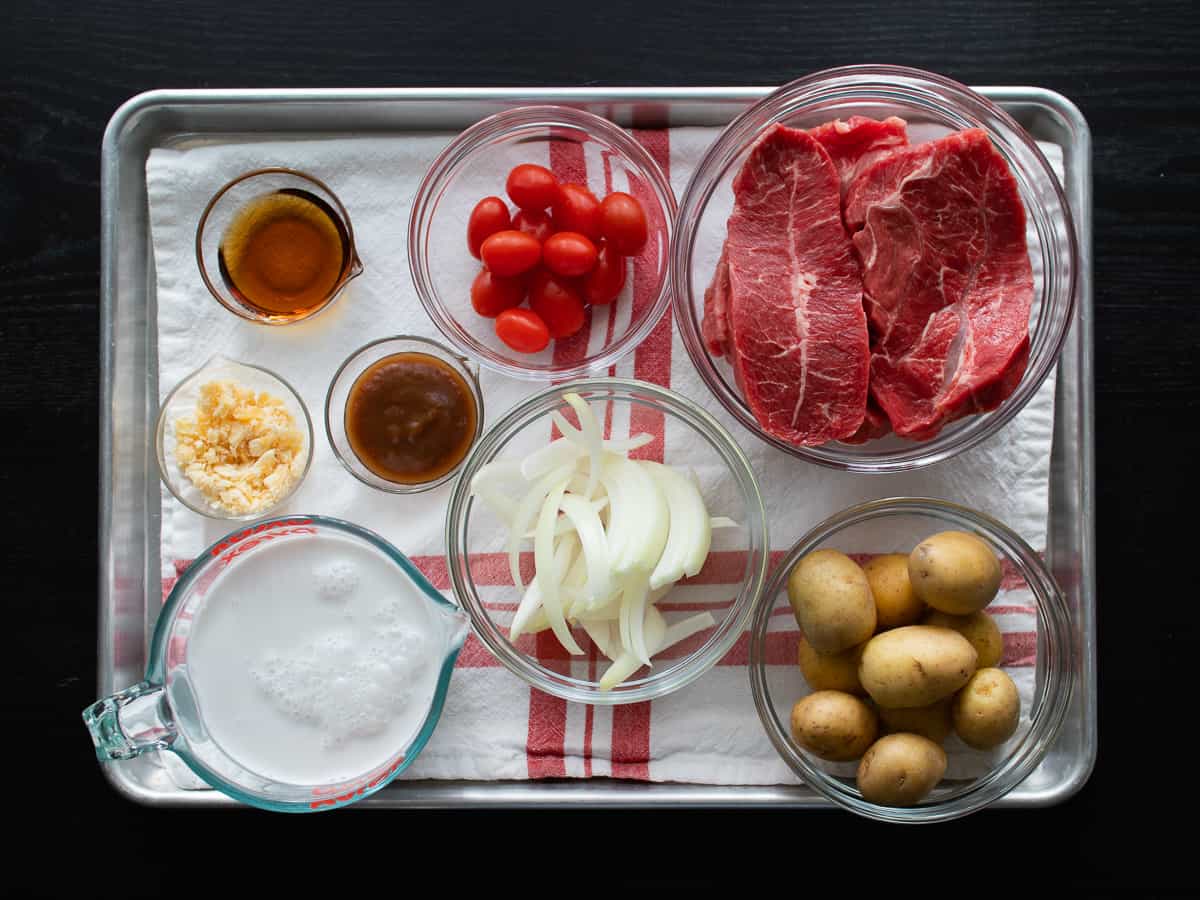
- Chuck top blade steaks, or another stew-friendly cut that's not too chewy. More on choosing the right cut of beef below.
- Salt (not pictured)
- Thai yellow curry paste, store bought or homemade (not pictured).
- Coconut milk, always use full fat coconut milk for cooking. Read this post for how to choose the best coconut milk.
- Waxy potatoes such as new potatoes, or you can also sub sweet potatoes
- Onion
- Fish sauce
- Palm sugar or light brown sugar
- Tamarind paste, this is there just to add a little acidity and balance out the richness (Thai food is all about balance!) If you don't have any, a little lime juice or lemon juice will also work.
- Grape or cherry tomatoes for pops of colour and acidity. You can also substitute red bell pepper.
- Jasmine rice for serving
Yellow Curry Paste Ingredients
Before we get into the paste ingredients, let me first assure you that you do NOT need to make your own curry paste in order to make a "legit" Thai curry. Most Thai people buy the paste as well! If you ARE buying, read about how to choose the best curry paste below.
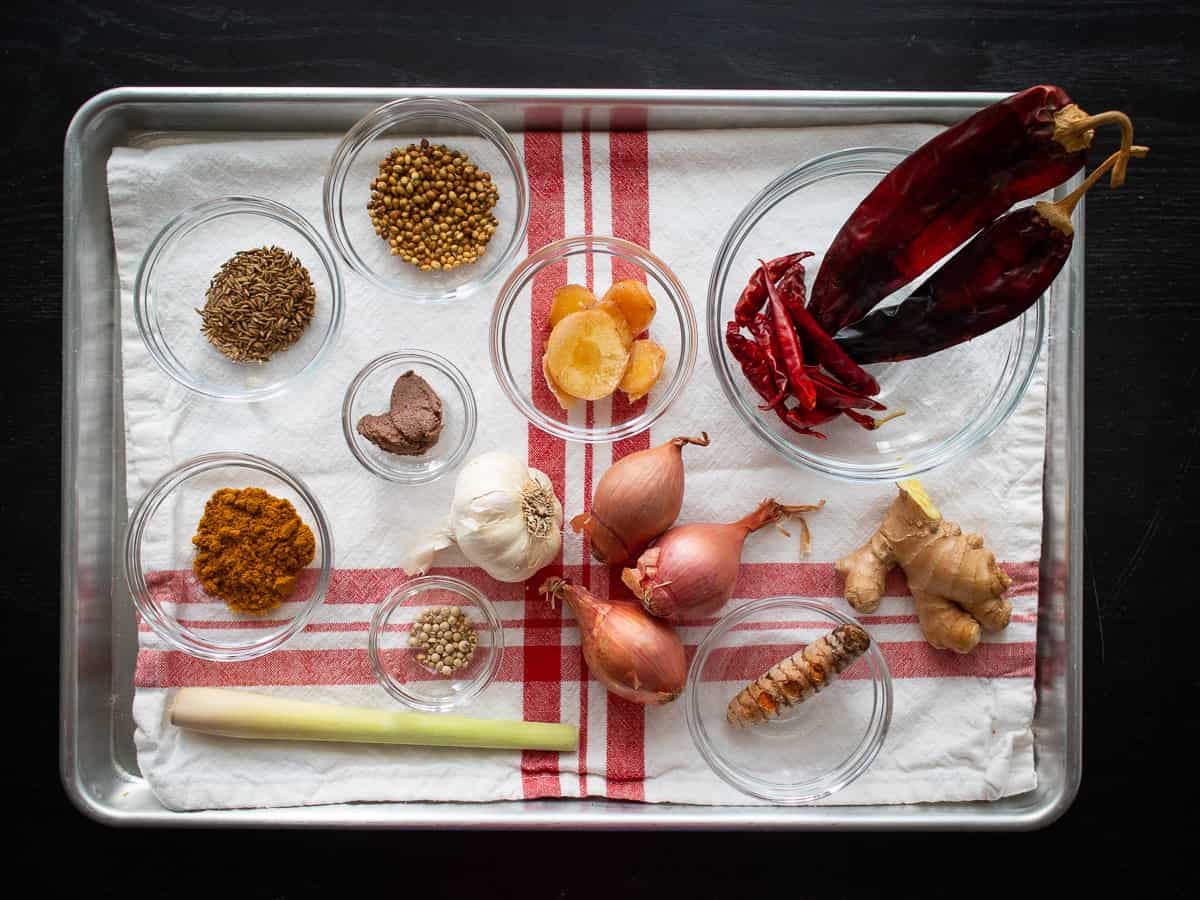
- Dried chilies. Yellow curry is typically on the milder side, so I use mostly mild red peppers such as guajillo for the bulk of it. I then add a few spicier dried chillies (arbol or Thai) to make it a little spicier, and this is something you can add to your own taste.
- Coriander seeds, toasted
- Cumin seeds, toasted
- White peppercorns
- Salt
- Lemongrass, bottom half only for best flavor
- Ginger
- Galangal
- Fresh turmeric, or turmeric powder
- Garlic
- Shallots
- Curry powder, the generic "curry powder" at your local Asian market will work. I personally like the Japanese S&B brand, but if it smells good to you, it's good to use.
- Fermented shrimp paste (gapi), optional
How to Make Yellow Curry Beef
Here's a bird's eye view of the process, but I highly recommend watching the video tutorial in the recipe card to ensure success!

- If making the curry paste, pound the lemongrass, galangal, ginger and turmeric into a fine paste.
- Grind the dried spices in a coffee grinder, then add to the mortar along with the garlic and shallots.
- Pound into a fine paste.
- This recipe calls for only half of what you're making here, and the other half can be frozen for next time. P.S. I don't recommend using a food processor for this, as it doesn't get the paste fine enough - but a good immersion blender works perfectly. See my massaman curry paste video on how to use it.

- Slice the steak thinly, then add to a medium pot and cover with water. Add salt and 1 tablespoon of the curry paste.
- Bring to a simmer, then reduce the heat to maintain that simmer for 20-25 mins and until the beef is fork tender.
- Meanwhile, make the curry sauce. Reduce ¾ cup of the coconut milk over medium-high heat by about half volume, then add the curry paste and stir over medium low heat for 5-8 minutes.
- Once the paste is thick and the coconut oil separates from the paste, add the remaining coconut milk, the sugar, 1 tablespoon of the tamarind paste and 1 tablespoon of the fish sauce; stir to mix and bring to a boil.
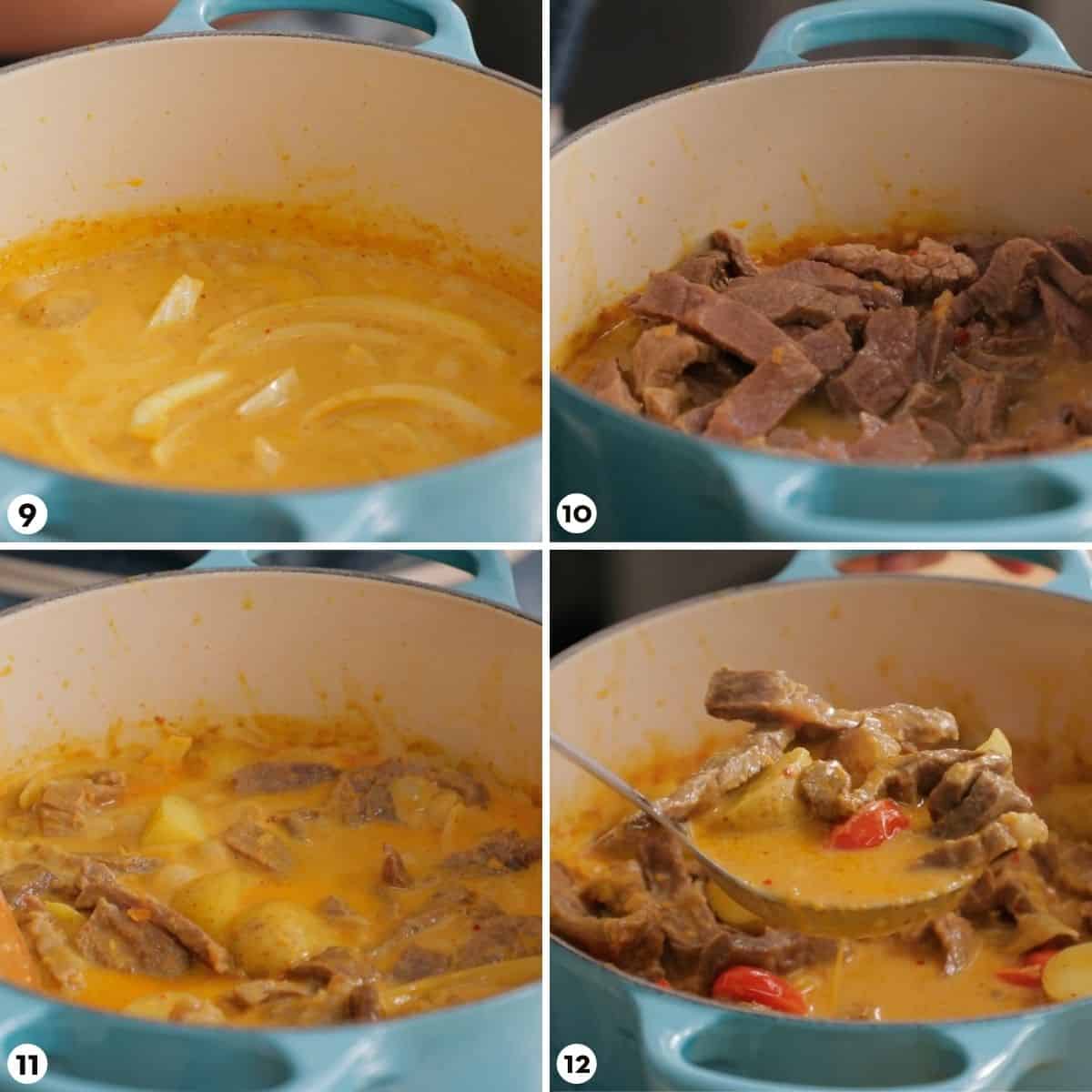
- Add the potatoes and onions and simmer for 5-7 minutes, until the potatoes are about halfway cooked. Remove from the heat while you wait for the beef to be done.
- Once the beef is tender, use a slotted spoon to transfer only the beef into the curry. Then add only as much of the beef cooking liquid to keep everything barely submerged. (The remaining beef cooking liquid is super tasty, and you can save it to make a soup such as a beef noodle soup!)
- Turn the heat back on and simmer the curry for another 5-7 minutes or until the potatoes are fully cooked.
- Taste the sauce and adjust seasoning with more fish sauce, sugar or tamarind as needed. Stir in the tomatoes then turn off the heat and allow the tomatoes to soften in the residual heat for a minute or so. Serve with jasmine rice.
Tricks to Making a Faster Beef Curry
There are a few tricks I employed to make this beef curry weeknight-friendly, rather than it being a 3 hour ordeal, and without needing a slow cooker or a pressure cooker.
Save this recipe!
- Thinly slicing the beef as if you were making a stir fry. People tend to cut beef in cubes or big chunks for curries and stews, and while that makes a pretty curry, you'll need 2-3 hours of braising time to fully tenderize the beef.
- Choosing a cut that's not too chewy so it won't take as long to tenderize. Brisket, for example, is very tough and should not be used.
- Braising the beef separately from the curry sauce allows you to multitask. The beef can braise while you make the curry sauce.
- Cut your potatoes into smaller pieces. People tend to think big chunks for curry, but 1-inch pieces allows for faster cooking time and also better flavour absorption in a shorter amount of time.
Want an even faster beef curry? Try my panang curry recipe here!
How to Choose the Best Thai Curry Paste
If you're not making your own paste, great! Store-bought curry paste can even be better than homemade ones, especially if you have to make substitutions for certain ingredients.
You can find yellow curry paste at most Asian grocery stores, and even some non-Asian ones. My preferred one is Mae Ploy Brand, which has a great flavour, but Aroy-D is also good. Both of these do not contain shrimp paste (gapi), however so I like to add my own to it, but it's not necessary.
Whether you're buying yellow, green, or red curry paste, here are a few tips when shopping:
- The ingredient list should include nothing besides herbs, spices, salt and shrimp paste. I try to avoid ones with additives; oil, sugar, or other seasonings. It's not a terrible thing to have seasonings added, but I like to keep the curry paste as pure as possible so I have the most control over the final taste of the curry.
- Make sure it is a product of Thailand.
- Make sure it does NOT say yellow sour curry paste, which is for the wrong kind of yellow curry. (Though you can use it for this sour curry recipe!)
Choosing the Right Cut of Beef
For this recipe you want a flavourful cut of beef that is not too chewy so that it wouldn't take too long to tenderize. You don't need an expensive cut for this!
The restaurant where I learned this quick-curry-making trick used flank steak, and it was fine. Flank is an inexpensive and widely available choice, though it is a little too lean for my taste.
I use chuck top blade which has a great amount of marbling and a good beefy flavour. It's available at my local Asian supermarket, and I think you'll have better luck there rather than at a Western butcher.
Regular chuck roast will also work, but look for one that has some marbling in it. Beef that is too lean will feel dry after braising.
A Useful Tool for Navigating Beef Cuts
(Ad) There are so many cuts of beef on the market, and if you've ever wanted to try a new beef cut but not sure what to do with it, check this out. Canada Beef, our sponsor for this post, has launched the Canadian Beef Information Gateway which breaks down over 70 cuts of beef, complete with info on how to best cook them and new recipes you can try out.
Check it out and you'll be amazed! Access the Gateway here or scan the QR code below!

Storing Leftovers
As with most curries, this will taste even better the next day. Store in an airtight container in the fridge and it should last you at least a week.
When reheating, be careful not to overdo it as you do not want to over-cook the potatoes while you reheat.
More Thai recipes for a Weeknight
- A fan of pineapple in savoury dishes? This Red Curry with Shrimp and Pineapple is a must-try.
- Red Curry Stir Fried Tuna does not get any easier, but packs a punch of fiery Thai flavours!
- Holy Basil Stir Fry with Beef is a cult-favourite. This one is the "original" style that's simpler but just as tasty!

Quick Thai Yellow Curry with Beef & Potatoes
Equipment
- mortar and pestle if making the curry paste
Save this recipe!
Ingredients
- 1 ½ lb chuck top blade steaks , see note 1
- 1 teaspoon table salt
- 6 tablespoon yellow curry paste, store bought or half batch of homemade paste, recipe below
- 2 cups coconut milk
- 10.5 oz waxy potatoes, 1-inch chunks
- ½ medium onion, cut lengthwise into slivers
- 1 - 2 tablespoon fish sauce
- 2 tablespoon palm sugar, finely chopped
- 1 - 2 tablespoon tamarind paste
- ¾ cup cherry tomatoes
- Jasmine rice, for serving
Homemade Yellow Curry Paste (makes enough for 2 batches of curry)
- 0.7 oz dried mild chilies, cut into ½-inch chunks, see note 2
- 1 tablespoon coriander seeds, toasted
- 1 ½ teaspoons cumin seeds, toasted
- ½ teaspoon white peppercorns
- 1 teaspoon table salt
- 1 stalk lemongrass, bottom half only, finely sliced
- 2 tablespoons finely chopped ginger
- 2 tablespoons finely chopped galangal
- 1 tablespoon chopped turmeric , or ½ teaspoon turmeric powder
- 6 cloves garlic, finely chopped
- ½ cup cup finely chopped shallots
- 1 tablespoon curry powder
- 2 teaspoons fermented shrimp paste
Notes
- Chuck top blade is a steak that can be found at Asian supermarkets and has a good amount of marbling with a tendon running through the middle. You can use regular chuck as well.
- Though yellow curry is usually on the milder side, you can make the curry spicier by replacing some of the mild dried chilies with hotter ones, such as chiles de arbol or Thai chilies.
FULL VIDEO TUTORIAL
All my recipes come with step-by-step video tutorials with extra tips not mentioned in the blog post, so make sure you watch the video to ensure success. If you enjoy them, consider subscribing to the YouTube Channel to not miss an episode. Thank you!
Subscribe to my YouTube ChannelInstructions
- Slice the steak crosswise into ⅛-inch thick slices and add to a small pot. Add enough water to completely submerge the beef, then add the salt and 1 tablespoon of the curry paste. Bring to a simmer over high heat. Once simmering, reduce heat to medium low to maintain a simmer and cook for 20-25 mins or until fork tender; timing will vary if using different cuts of meat. Skim off any scum that floats to the top.1 ½ lb chuck top blade steaks, 1 teaspoon table salt, 6 tablespoon yellow curry paste
- Meanwhile, make the curry sauce. In a heavy medium pot add ¾ cup (180 ml) coconut milk and bring to a boil.2 cups coconut milk
- Add the remaining curry paste and stir to mix well. Turn heat to medium low and stir constantly until very thick and the coconut oil separates from the paste; about 5-8 minutes (the oil may not separate depending on the coconut milk you’re using; this is okay.)6 tablespoon yellow curry paste
- Add the remaining coconut milk, sugar, about half of the tamarind paste and about half of the fish sauce; stir to mix and bring to a boil.2 cups coconut milk, 2 tablespoon palm sugar, 1 - 2 tablespoon tamarind paste, 1 - 2 tablespoon fish sauce
- Add the potatoes and onions and simmer for 5 minutes, uncovered, then remove from heat while you wait for the beef to be done; the potatoes should not be fully cooked yet at this point.10.5 oz waxy potatoes, ½ medium onion
- Once the beef is tender, use a slotted spoon to transfer only the beef into the curry. Then add only as much of the beef cooking liquid needed to keep everything barely submerged. (The remaining beef cooking liquid is super tasty, and you can save it to make a soup such as a beef noodle soup!)
- Turn the heat back on and simmer the curry, uncovered, for another 5-7 minutes or until the potatoes are fully cooked; timing may vary depending on the size. Taste the sauce and adjust seasoning with more fish sauce, tamarind or sugar as needed.
- Stir in the tomatoes then turn off the heat and allow the tomatoes to soften in the residual heat for a minute or so. Serve with jasmine rice.¾ cup cherry tomatoes, Jasmine rice
For the curry paste:
- In a coffee grinder, add the dried chilies, coriander seeds, cumin seeds and white peppercorns and grind into a fine powder.0.7 oz dried mild chilies, 1 tablespoon coriander seeds, 1 ½ teaspoons cumin seeds, ½ teaspoon white peppercorns
- You can do the next part using an immersion blender, or in a large granite mortar and pestle.
- If using a mortar and pestle: Add the lemongrass, ginger, galangal, fresh turmeric and salt and pound into a fine paste. Add the garlic, shallots and curry powder and pound into a paste. Add the ground chili mixture and shrimp paste and pound into a fine paste.You need only half of the paste for this recipe, and any leftovers can be frozen.1 teaspoon table salt, 1 stalk lemongrass, 2 tablespoons finely chopped ginger, 2 tablespoons finely chopped galangal, 6 cloves garlic, ½ cup cup finely chopped shallots, 1 tablespoon curry powder, 2 teaspoons fermented shrimp paste, 1 tablespoon chopped turmeric
- If using an immersion blender: In a narrow container such as a glass measuring cup, add the lemongrass, ginger, galangal, turmeric, salt, garlic, shallots, curry powder and shrimp paste and blend until fine. You’ll need to lift and reposition the blender multiple times as the paste is thick. Once the paste is fine, add the ground chili mixture and blend to mix well.You need only half of the paste for this recipe, and any leftovers can be frozen.



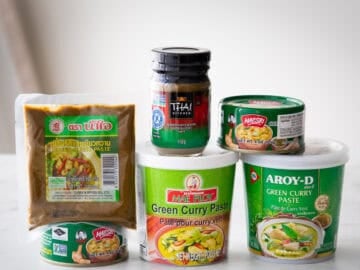


Rebecca says
One of my favourite curry recipes, storebought curry paste makes this a very weeknight-friendly meal!
Jessica says
The beef is super tender. I did use the suggested chuck top blade steak. I was hesitant that it would be tender but it was perfect. I also made my own yellow curry paste and it was worth the time preparing that. This dish is incredibly flavorful. Much tastier than restaurant version. I'm not sure what to do with the leftover liquid from the beef. Do you have any suggestions? Thank you
Pailin Chongchitnant says
Hi! So glad to hear! You can freeze it and save it as a base for making soup, even a noodle soup would be nice 🙂
Jessica says
Any receipe suggestions for the beef base from your new cookbook Sabai?
Pailin Chongchitnant says
You can probably use it as the liquid for either the turmeric fish soup for a richer broth, or for the use it in the liquid of the braised chicken noodle soup. You'll need to adjust seasoning obviously since you're introducing a new ingredient here.
Andreea says
Hello!
This recipe looks super nice. Can't wait to try it.
What kind of curry powder did you use?
Pailin Chongchitnant says
I just Japanese SB Brand, but you can use whichever kind you like 🙂
Rick says
This may be only a coincidence. However, I have had Yellow Curry Beef w/Potatoes several times in Southern Thailand and Bangkok. I don't ever remember seeing tomatoes in it. Did I miss something or is that your idea? It sounds fine to me, I just don't remember seeing it served that way.
I do remember seeing tomatoes in the markets and thinking how small they always looked compared to our gigantic ones.
Pailin Chongchitnant says
Hi! Tomatoes are not always added, especially in restaurants that make a large batch of curries which they then keep hot for a while, because tomatoes cannot withstand being kept in a hot curry without turning to mush. So it only works in small-batch cooking or some places add them to-order.
Norbert says
Hi Pailin,
it´s always good having Thai for weeknight cooking. Fast, good taste and yummy. When I cooked one of your luscious Thai curries I had some leftover-sauce, put it to the fridge. Next time I just added some protein and fresh peppers and guess what - another weeknight pleasure. Sometimes I´m using a steamer/instant pot to get tender beef faster.
br from Germany
Norbert
Pailin Chongchitnant says
Love having leftover sauce, makes next meal so easy!